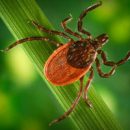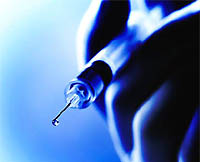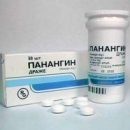Ticky encephalitis is one of the dangerous diseases in its consequences. Vaccination is applied to specific prevention of this disease. In addition, immunoglobulin against tick-borne encephalitis can be applied to emergency prevention.
Content
Vaccination against tick-borne encephalitis virus
The main method of preventing tick-borne encephalitis is vaccination.
It is believed that the effectiveness of the vaccine from tick-borne encephalitis is more than 95%, t. E. It prevents at least 95 cases of the disease.
The vaccination against tick-borne encephalitis is recommended to people living on endemic to tick-borne encephalitis territories, as well as persons planning trips to these areas.
 The vaccination against tick-borne encephalitis can be carried out from 1 year. Vaccination in children up to 1 year, as a rule, is recommended only if there is a real hazard of infection.
The vaccination against tick-borne encephalitis can be carried out from 1 year. Vaccination in children up to 1 year, as a rule, is recommended only if there is a real hazard of infection.
Standard vaccination diagram from tick-borne encephalitis includes 3 vaccinations. Primary vaccination consists of two vaccines conducted with an interval of 1-3 months. Usually it is carried out in the cold season, and finish no later than 14 days before the start of the adhesive activity period. If necessary, the interval between the first two vaccines can be reduced to two weeks. The third vaccination is carried out 9-12 months after the second.
Emergency vaccination scheme is designed to quickly generate immunity if the duration of the standard vaccination was missed. In this case, the second vaccination is carried out two weeks after the first, and the third in 9-12 months after the second vaccination. Emergency vaccination scheme gives the same persistent immunity as under the standard vaccination scheme.
Whatever the vaccination scheme, immunity to the tick-borne encephalitis virus appears on average only two weeks after the introduction of the second dose. The third dose is usually introduced to fix immunity.
After the full course of vaccination, the immunity against the tick-borne encephalitis virus is preserved for three years, after which revaccination is necessary. It is held every 3 years in the form of one vaccination.
Vaccination against tick-borne encephalitis in such major cities as Petrozavodsk, Omsk, St. Petersburg, Krasnoyarsk, Izhevsk, Murmansk, Novosibirsk and others, as a rule, is carried out in the clinics of the city, including children, as well as commercial medical centers.
The following vaccines are currently used in Russia:
- Entsevir - for children older than 3 years and adults, production of FSUE NPO Microgen, MW Russia.
- Encephalitis Culture Cultural Peeled Concentrated Inactivated Dry Cleaning Vaccine - For children over 4 years old and adults. Production - an enterprise for the production of bacterium and viral drugs of the Institute of Poliomyelitis and viral encephalitis them.M.NS.Chumakov RAMS FSUE, Russia.
- FSME immun injection (from 16 years) and FSME-immun junior (for children from 1 to 16 years old) - production -Baxter Vaccine AG, Austria.
- Enceptur adult (from 12 years old) and enceptur children (for children from 1 to 11 years old). Production - Novartis vaccine and diagnosis of GMBH and.Kg, Germany.
Modern vaccines - Pulty and imported contain inactivated (killed) tick-borne encephalitis virus. Live virus in vaccines against tick-borne encephalitis no.
It is believed that imported vaccines are less than a list of contraindications and the frequency of adverse reactions, they are better tolerated.
The main contraindications for the introduction of vaccine against tick-borne encephalitis are:
- Acute feverish states of any etiology and aggravation of chronic infectious diseases;
- Heavy allergic reactions in the history of food (especially chicken protein), medicinal substances;
- Strong reaction (temperature rise above 40°C, at the site of the introduction of vaccine - swelling, hyperemia more than 8 cm in diameter) or complication on the previous dose of vaccine;
- Pregnancy.
In addition, contraindications for the introduction of domestic vaccines are:
- Bronchial asthma;
- Systemic diseases of the connective tissue;
- Tuberculosis;
- Rheumatism;
- Epilepsy with frequent seizures;
- Chronic diseases of the liver and kidney during the exacerbation period, cardiovascular insufficiency of 2-3 degrees, transferred myocardial infarction, stroke;
- Diabetes, thyrotoxicosis and other pronounced endocrine disorders;
- Malignant neoplasms, blood disease.
The vaccine against tick-borne encephalitis is introduced intramuscularly, as a rule, in the region of the upper third of the shoulder.
In some cases, after the introduction of vaccine, local and general reactions may develop. Local reactions are expressed in redness, swelling, soreness at the injection site, the development of infiltration, as well as an increase in regional lymph nodes.
Common reactions are usually developing in the first two days after vaccination and can be expressed in a rise of temperature to 38 degrees, headaches, ailments, pain in muscles and joints, nausea, vomiting, paresthesias, neuritis, short-term rash, as well as allergic reactions.
Emergency prevention of tick-borne encephalitis
For emergency prevention of non-vaccinated people or persons who received one vaccination, conduct passive immunization with specific immunoglobulin against tick-borne encephalitis.
Immunoglobulins or antibodies are proteins that are produced by in-lymphocytes of the body under the influence of alien agents (antigens) and have the ability to specifically bind to them, neutralizing them.
Immunoglobulin against the tick-borne encephalitis virus is introduced intramuscularly into the upper outer quadrant of the bridge muscle or in the outer surface of the thigh.
Immunoglobulin can be introduced before possible bite of tick in endemic on tick-borne encephalitis area. In this case, its protective effect is manifested 24-48 hours after the introduction and lasts about four weeks. If it is necessary to preserve immunological protection in case of danger of infection with tick-borne encephalitis, it is recommended to repeat the administration of immunoglobulin after four weeks. Introduction Immunoglobulin is able to prevent no more than 60% of cases of tick-borne encephalitis. It must be remembered that the protective effect of immunoglobulin against the tick-borne encephalitis virus is much weaker than vaccinations.
Immunoglobulin is also introduced in order to emergency prevention after the bite of a tick on the endemic over the tick-borne encephalitis of territories. First of all, it is introduced to people who are unseen against tick-borne encephalitis or received an incomplete course of vaccination. In this case, the drug must be introduced no later than 4 days after the tick bite. Also, immunoglobulin can be used in case of suspicion of laboratory infection with a tick-borne encephalitis virus.
Usually, the emergency immunoprophylaxis of tick-borne encephalitis for people affected by tick bites is carried out in specialized urban centers. Addresses of some of them can be found here.
In addition, immunoglobulin is used with therapeutic purposes. In this case, it is introduced the earliest time after the onset of the disease in various dosages, depending on the mass of the body and the clinical form of infection, the severity of the flow and the period of the disease.









